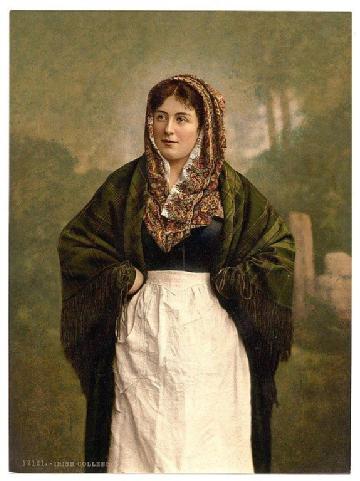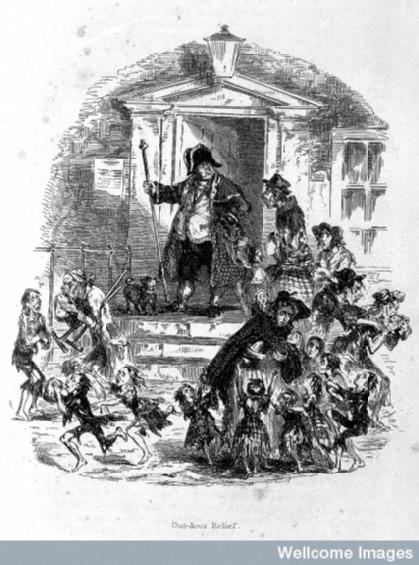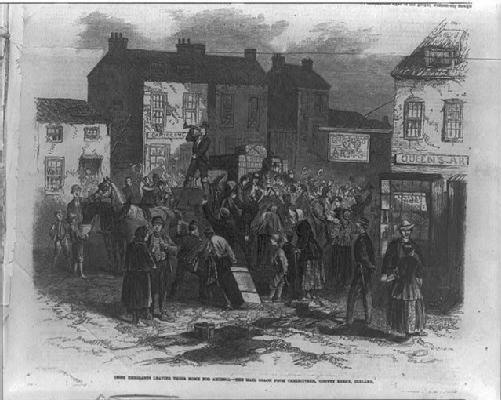"Kin to Nobry": The Irish, Migration and Isolation in Nineteenth-Century Lancashire

Many of the Irish migrants who were admitted to asylums and workhouses in Lancashire during the nineteenth century had experienced isolation and a lack of community support when they arrived in England. One such individual was Bridget Connor. A 35-year-old Irish seamstress, Bridget was married with two children. When she was admitted to the Prestwich Asylum, Manchester, in 1851 the asylum superintendent described her as 'very noisy, and incoherent in speech’. As Elizabeth Malcolm explains Bridget's 'breakdown was ascribed to the fact that her husband was gone to America and, not having heard from him for some time, she feared he might be dead’. Bridget, like many of the Irish inmates of Lancashire asylums, became a long-term asylum patient and, despite signs of recovery, she died in the asylum in 1861.
During the nineteenth century, English families often sought the admission of insane and troublesome relatives when they could no longer cope with their behaviour and in some cases subsequently petitioned for their removal from the asylum back to the family home when they felt they could manage again. Many Irish-born asylum patients in Lancashire asylums, however, were single and towards the end of the nineteenth century the typical Irish inmate was a middle-aged woman who had either never married or was widowed or even deserted. These older women often found it difficult to hold down a job, especially if it was physically demanding. With little or no family in England and no employer to return to, many Irish inmates were never discharged from the asylum. Catherine Cox, Hilary Marland and Sarah York have explained that, when in England, 'Irish patients tended to be isolated and without access to kin', especially as after the Famine period Irish migrants were less likely to travel to England in family groups. In the case of Liverpool’s Rainhill Asylum, between 1856 and 1906 50 per cent of male Irish patients and 40 per cent of female Irish patients admitted to the institution were single.

In addition to marital status and gender, poverty, was a key factor in the over-representation of Irish migrants in Lancashire asylums (see ‘Poverty, Welfare and Insanity amongst Irish Migrants’). Many patients had been afforded little or no job security once in Lancashire. Women were likely to have been in domestic service, whilst many men had been casual manual labourers before admission. These jobs were temporary and furthermore, many Irish migrants sent what little they earned to relatives back in Ireland as ‘remittances’. Elizabeth Rourke, a single domestic servant, was 25-years-old when she was admitted to Rainhill asylum in 1867. When Elizabeth's mistress 'went away with her clothes and without paying her wages, in fact leaving her destitute', Elizabeth went to the workhouse and 'becoming melancholic was transferred to the asylum.' With workhouse populations, swelling, violent or unmanageable inmates were often sent to the asylum.
‘Poor people coming to a workhouse for food’ (c. 1840),

In 1883 Lancashire dialect poet Edwin Waugh reflected on the experience of migrants arriving in England without kinship networks or close communities for support. Waugh wrote of a migrant from Limerick travelling to London whose friend died before his arrival in the city: 'I keep lookin' up an' down to see if I can leet of onybody fro our side, - but I can find noan. I'm like as I wur born alive an' kin to nobry.' In her study of insanity in New South Wales, Catharine Coleborne explains that migrants from the British Isles were often admitted to asylums because of feelings of loneliness and isolation. Nineteenth-century commentators made similar observations. In 1873, Edward Paley, the Inspector of Lunatic Asylums for Victoria, remarked that:
The separation of patients from relations, friends, home and local interest, deprives them of a very powerful and important means of restoration to sound reason. . . nothing so much tends to help their progress towards recovery as the presence and personal sympathy of relations or friends in whom they can have confidence and trust.
However, not all migrants felt such a sense of isolation. Indeed, Michael Anderson has argued that Irish immigrants clustered together in Lancashire towns, with other Irish migrants, but particularly with those from the same village in Ireland. In other areas Irish communities formed around industries, for instance in the town of Burslem near the Staffordshire Potteries. Still, many Irish migrants, especially those who were single and lacking a kinship group in England, did not have adequate support in times of need and were, therefore, particularly susceptible to being admitted into a workhouse or an asylum; an admission which was all too often permanent. The Commissioners in Lunacy advised the Lancashire Asylum Visiting Committees in the 1880s that patients who were seldom or never visited should be sent to the more distant Whittingham or Lancaster Asylums; for patients such as the friendless Irish ‘it is of no moment in which asylum they be placed’.
Further Reading:
Michael Anderson, Family Structure in Nineteenth Century Lancashire (Cambridge University Press, 1971).
Andrew August, The British Working Class: 1832-1940 (Pearson Longman, 2007).
Catherine Cox, Hilary Marland and Sarah York, 'Emaciated, Exhausted, and Excited: The Bodies and Minds of the Irish in Late Nineteenth-Century Lancashire Asylums', Journal of Social History, 46:2 (2012), 500-24.
Catherine Cox, Hilary Marland and Sarah York, ‘Itineraries and Experiences of Insanity: Irish Migration and the Management of Mental Illness in Nineteenth-Century Lancashire’, in Catherine Cox and Hilary Marland (eds), Migration, Health and Ethnicity in the Modern World (Palgrave Macmillan, 2013), 36-60.
Angela McCarthy and Catharine Coleborne (eds), Migration, Ethnicity, and Mental Health (Routledge, 2012).
Elizabeth Malcolm, '"A Most Miserable Looking Object" - The Irish in English Asylums, 1851-1901: Migration, Poverty and Prejudice', in John Belchem and Klaus Tenfelde (eds), Irish and Polish Migration in Comparative Perspective (Klartext Verlag, 2003), 115-26.
John Walton, 'Casting Out and Bringing Back in Victorian England: Pauper Lunatics, 1840-70', in W.F. Bynum, Roy Porter, and M. Shepherd (eds), The Anatomy of Madness: Essays in the History of Psychiatry, vol. 2 (Tavistock, 1985), 137-41.
